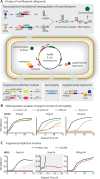Multilayered genetic safeguards limit growth of microorganisms to defined environments
- PMID: 25567985
- PMCID: PMC4330353
- DOI: 10.1093/nar/gku1378
Multilayered genetic safeguards limit growth of microorganisms to defined environments
Abstract
Genetically modified organisms (GMOs) are commonly used to produce valuable compounds in closed industrial systems. However, their emerging applications in open clinical or environmental settings require enhanced safety and security measures. Intrinsic biocontainment, the creation of bacterial hosts unable to survive in natural environments, remains a major unsolved biosafety problem. We developed a new biocontainment strategy containing overlapping 'safeguards'-engineered riboregulators that tightly control expression of essential genes, and an engineered addiction module based on nucleases that cleaves the host genome-to restrict viability of Escherichia coli cells to media containing exogenously supplied synthetic small molecules. These multilayered safeguards maintain robust growth in permissive conditions, eliminate persistence and limit escape frequencies to <1.3 × 10(-12). The staged approach to safeguard implementation revealed mechanisms of escape and enabled strategies to overcome them. Our safeguarding strategy is modular and employs conserved mechanisms that could be extended to clinically or industrially relevant organisms and undomesticated species.
© The Author(s) 2015. Published by Oxford University Press on behalf of Nucleic Acids Research.
Figures




References
-
- Paddon C.J., Westfall P.J., Pitera D.J., Benjamin K., Fisher K., McPhee D., Leavell M.D., Tai A., Main A., Eng D., et al. High-level semi-synthetic production of the potent antimalarial artemisinin. Nature. 2013;496:528–532. - PubMed
-
- Way J.C., Collins J.J., Keasling J.D., Silver P.A. Integrating biological redesign: where synthetic biology came from and where it needs to go. Cell. 2014;157:151–161. - PubMed
-
- Pieper D.H., Reineke W. Engineering bacteria for bioremediation. Curr. Opin. Biotechnol. 2000;11:262–270. - PubMed
-
- Steidler L. Genetically engineered probiotics. Best Pract. Res. Clin. Gastroenterol. 2003;17:861–876. - PubMed

